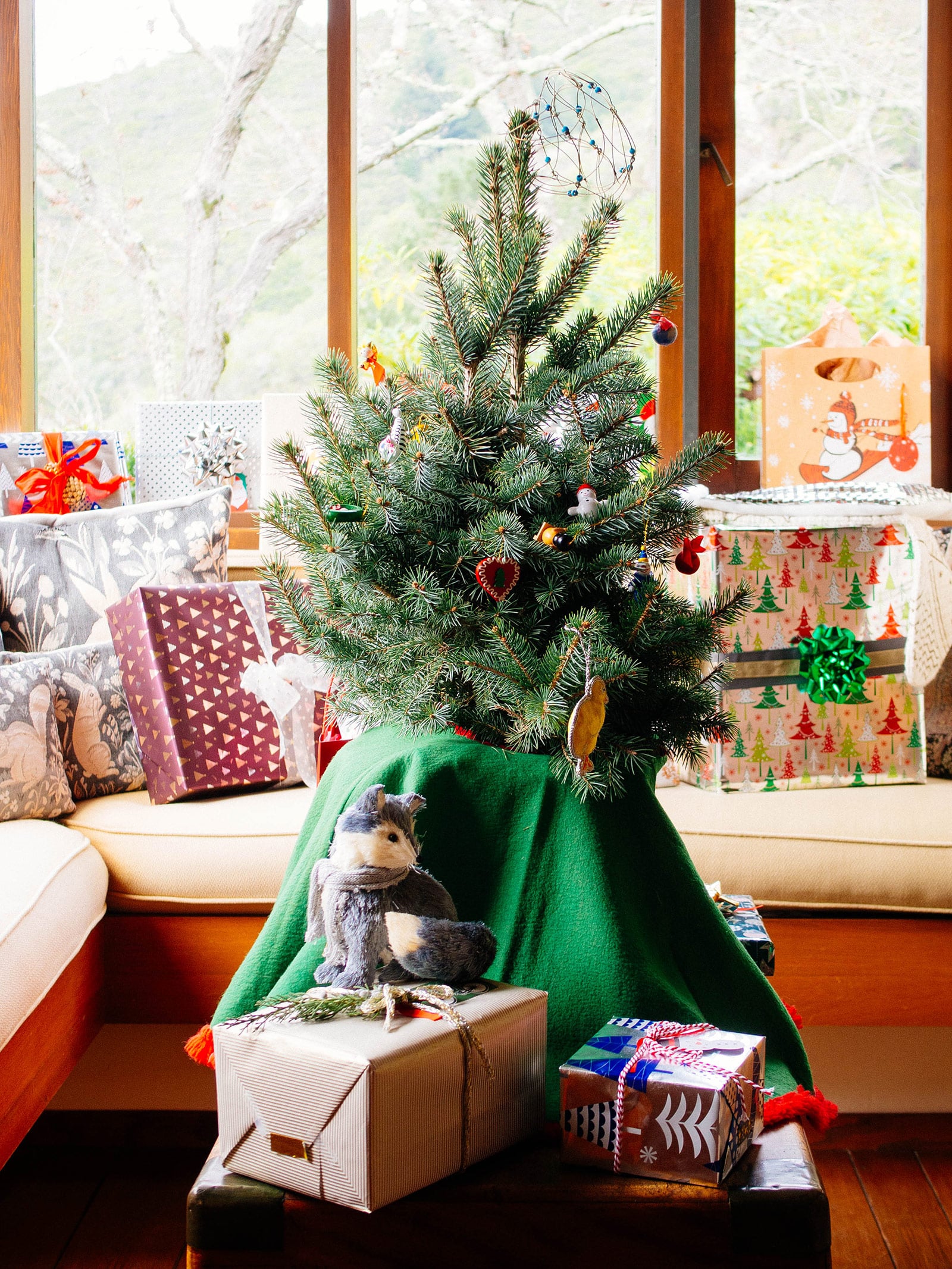Thinking of getting a live, potted Christmas tree for the holidays this year? I say go for it!
With the right care, you’ll be able to enjoy the look and scent of a real conifer tree as part of your holiday decor and then plant it in your yard so it can grow wild and huge (and bring back wonderful holiday memories every time you see it).
Keep reading for everything you need to know about how to care for a potted Christmas tree and how to plant it in your yard after the holidays!
Disclosure: If you shop from my article or make a purchase through one of my links, I may receive commissions on some of the products I recommend.
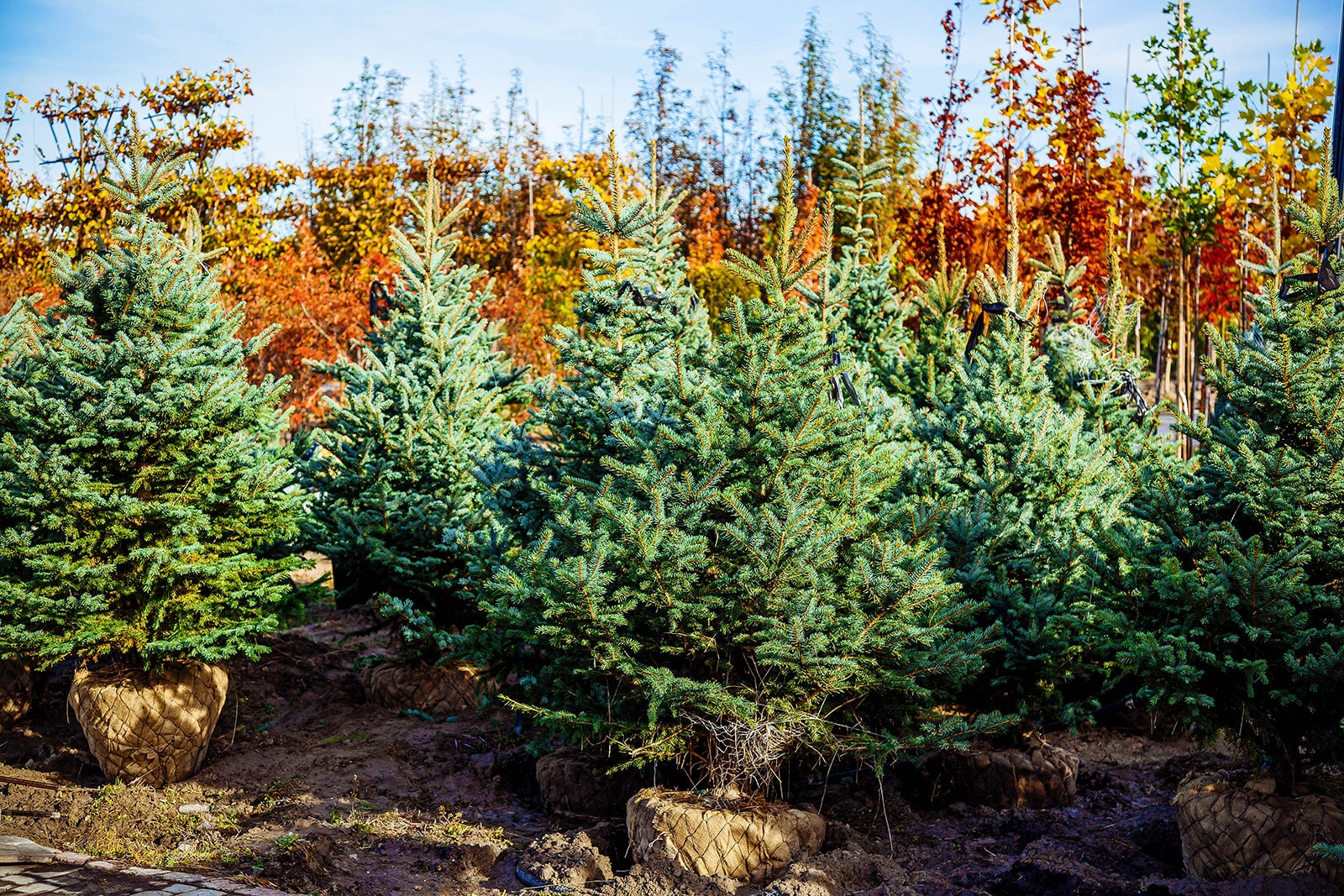
Living vs. artificial Christmas tree
For me, the holidays just aren’t the same without a live Christmas tree. I feel like the faux ones, even expensive high-end versions, never really nail the look. Using scent packages also isn’t quite the same as the smell of a real tree filling your home.
Additionally, even if you’d be throwing your tree away after the New Year (which is unnecessary since there are many clever ways to repurpose an old Christmas tree), live is actually more environmentally friendly than fake.
Christmas trees can be sustainably farmed and are biodegradable, after all… Not to mention the fun of going to pick out a tree or even cutting down a Christmas tree in the forest!
The reason we’re going for a potted tree here rather than a rootless, cut one is mainly that it’ll make an excellent addition to the yard afterward.
However, there are other reasons to consider it.
Did you know that potted trees are less of a fire hazard, since they don’t dry out as cut ones do? Additionally, with the right care there will be less needle shed and no risk of the tree ending up looking sad and crispy after a few weeks.
Tip: Buy your potted Christmas tree at your local nursery rather than a big box store. Aside from supporting the local economy, you’ll likely also get a higher-quality tree. This is important, because the healthier the tree, the more likely it’ll thrive after you’ve planted it outside.
Types of live Christmas trees
We’re not always aware of it when we buy one, but did you know there are loads of different kinds of Christmas trees out there? In fact, there are even Christmas trees that grow in the warm, sunny climate of Southern California!
But what’s interesting is that we USA folks and the Europeans don’t even prefer the same species.
They like Nordmann firs, which are beloved for the fact that they retain their needles well and last long. In the US, the blue-green Fraser fir appears to be the #1 favorite, probably due to its bushiness and sturdy branches.
What species will work in your backyard depends on where you live, so it pays off to choose the tree you’ll be planting based on species.
Let’s have a look at the available types and which USDA hardiness zones they can survive in!
Tip: Because of the soil and root ball, potted Christmas trees can be significantly heavier than their rootless counterparts. Don’t go out to buy one solo unless you’re okay with going for a smaller tree, or you may end up not being able to carry yours home!
In fact, potted trees are usually a little smaller in general, because a very large one would need a humongous planter.
The types of live Christmas trees you may come across locally include (but are definitely not limited to):
- Fraser fir (Abies fraseri): This holiday favorite is native to the Appalachian mountains. It’s quite hardy and can be planted outside in zones 4 to 7.
- Balsam fir (Abies balsamea): A very close cousin of the Fraser fir, this is a popular species due to its divine pine scent. It likes cool temperatures and does well in zones 3 to 5.
- Douglas fir (Pseudotsuga menziesii): Soft needles that don’t tend to drop easily. This one is native to western North America, thriving in warm summers but cool winters. Zones 4 through 6 should work well.
- Norway spruce (Picea abies): A European species that’s big in the US, especially for public spaces. The Rockefeller Center Christmas Tree is usually a Norway spruce! These hardy trees do well in zones 2 to 7.
- White pine (Pinus strobus): If you prefer a fluffier look on your tree, this one’s for you. After the holidays, it’ll be able to survive in zones 3 to 8.
- Alberta spruce (Picea glauca): You won’t see many full-sized specimens of Alberta spruce sold as Christmas trees, but they’re a big favorite for those who prefer a tabletop version. These will do well in zones 2 through 8.
- Scotch pine (Pinus sylvestris): Hardy and with strong, rigid branches, this one will do thrive best in gardens in zones 2 to 7.
- Colorado blue spruce (Picea pungens): Its nice blue-green color makes this a big favorite. It should work in zones 2 through 7. (This is also one of my top picks for planting afterward if you want a fast-growing tree for privacy.)
Don’t want to haul a tree home? Here’s a nice selection of living Christmas trees (for zones 2 through 10) that you can order online and ship right to your doorstep.
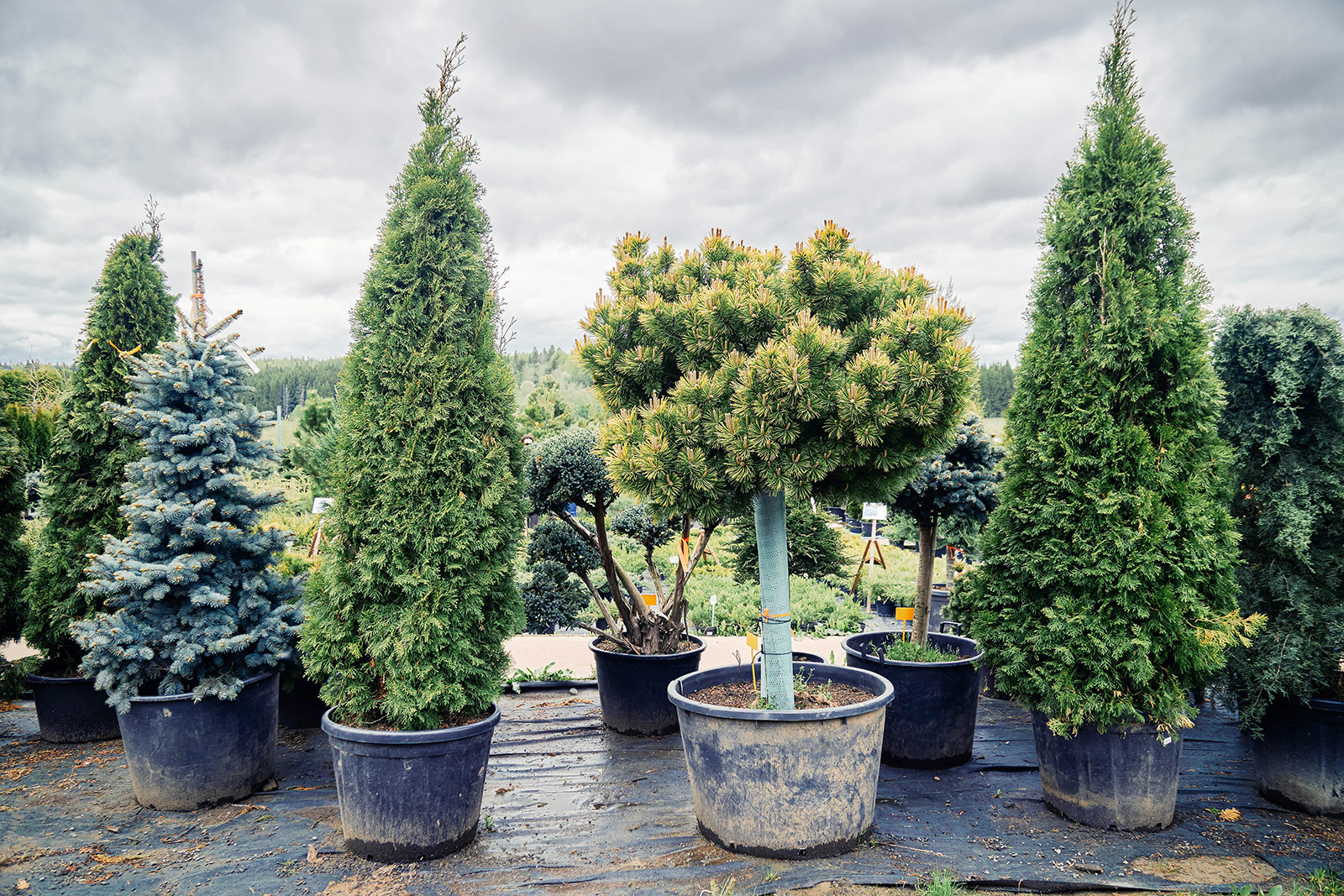
Conifer vs. non-conifer potted Christmas trees
Aside from the traditional Christmas conifers listed above, there’s another type of potted Christmas tree you’re likely to come across: the non-conifer variety. These unconventional Christmas trees include arborvitae, cypress, cedars, Norfolk Island pines, and even rosemary.
That’s right, a pruned rosemary bush is an excellent stand-in for those looking for a mini Christmas tree! This one might not smell like pine, but the scent is wonderful regardless. (The smell of rosemary is also believed to make you smarter and more alert.)
Often found for sale in supermarkets around the holidays (right next to the poinsettias, amaryllis, and other holiday plants), rosemary is a good choice for warmer climates, since it can thrive in zones 7 to 10.
So, what are some key differences between conifers and non-conifers as far as living Christmas trees are concerned?
In general, potted conifer trees grow 3 to 5 feet tall, while potted non-conifer trees grow 2 to 4 feet tall.
Conifers are sometimes sold with a burlap sack around the root ball, while non-conifers are almost always sold in a pot.
Conifers must be planted right after Christmas if you want to keep them alive, since they cannot be reused the following year (indoors, at least). Non-conifers, however, can be left in a pot outdoors after Christmas, cared for as an ornamental container tree, then brought back inside to be reused as a Christmas tree again.
| Conifer Trees | Non-Conifer Trees |
|---|---|
| Grown in a pot | Grown in a pot, or grown in a field and then dug up for transport and sale |
| Sold in a pot | Sold in a pot, or sold with a burlap sack around the root ball |
| Grows 3 to 5 feet tall | Grows 2 to 4 feet tall |
| Can be left outdoors in a pot after Christmas | Must be planted right after Christmas |
| Can be reused year after year | Cannot be reused (indoors) |
Potted Christmas tree shopping tips
Although you can give post-Christmas planting a try with any tree that has a root ball, some have a better chance of survival than others.
First off, try finding a tree that was container-grown, not dug up from a field and then potted. (If you’re buying the tree in person, the seller should know this information.)
The former will likely be a little more expensive, but since it hasn’t been through nearly as much trauma as the latter, it will likely do much better past the holidays.
Secondly, try to find a tree that’s planted in a pot with drainage. If the planter doesn’t have a hole in the bottom to let excess water drain, it becomes a lot more difficult to balance watering in such a way that you can prevent both rot and thirst.
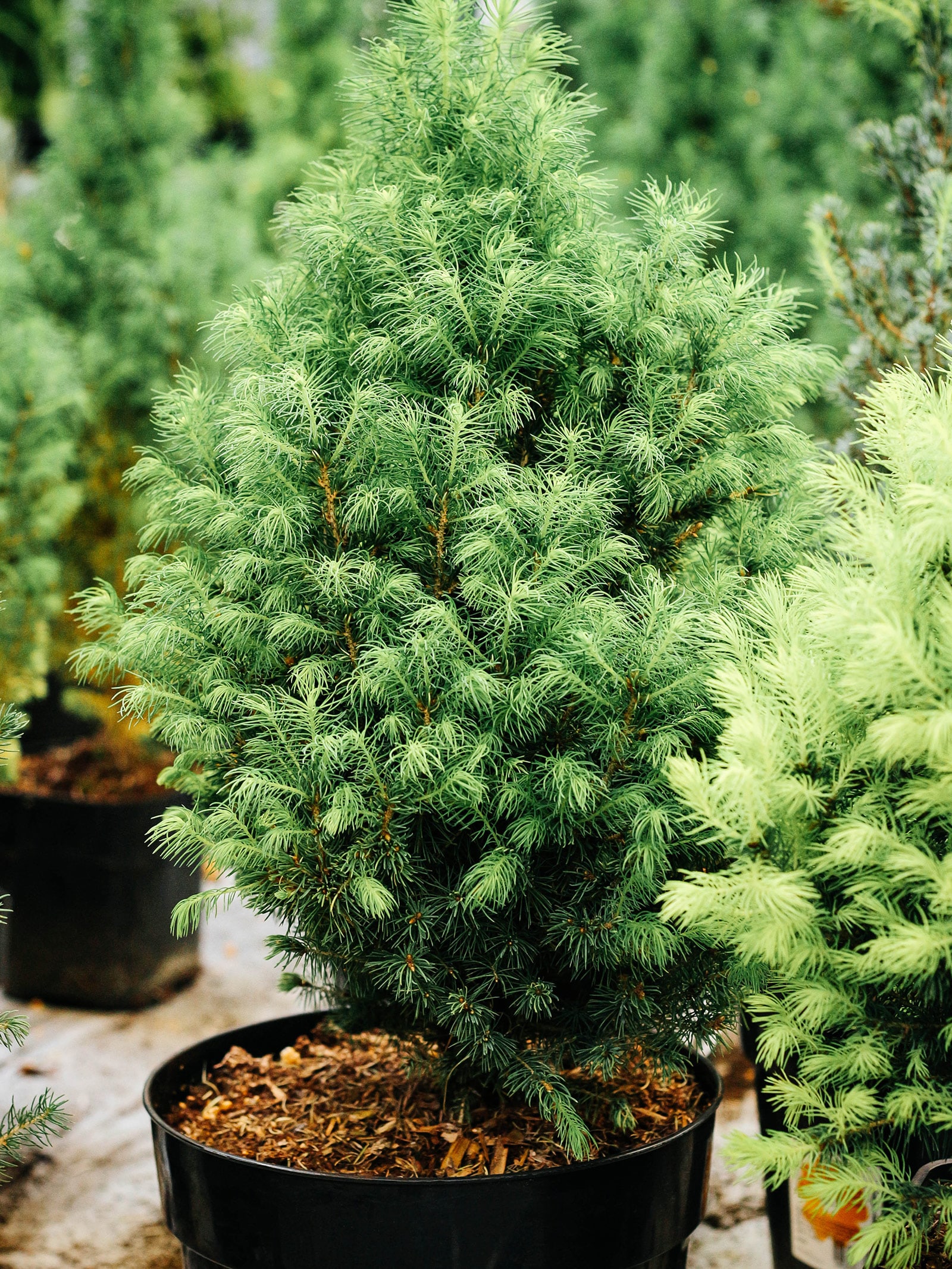
How to care for a potted Christmas tree
Once you’ve obtained your live potted Christmas tree, it’s a matter of keeping it alive until after the New Year. Spending a few weeks inside is not exactly something these conifer trees like, but it is possible to make its stay in your house a successful one with a little extra care!
Related: 7 Proven Tips and Tricks to Make a Christmas Tree Last Longer
Treat your tree as you would a houseplant, watering when needed and providing plenty of light. Cooler temperatures are preferred as well, but I know this is a little more challenging at home during winter.
Acclimating your potted tree
After purchase, keep your potted Christmas tree outdoors for as long as possible. I know, it’s a bit anti-climactic if the big Christmas tree hunt is a beloved family tradition, but the reality is that they just don’t like being in our warm and dry homes.
It’s a good idea to make the time your tree has to spend indoors as short as possible by not bringing it inside until about a week or two before Christmas. (That means no day-after-Thanksgiving tree shopping!)
Once you bring your living tree home, an acclimation period of about a week in a garage or other cool indoor spot helps make the transition from outdoors to indoors less hard on the plant.
If you lack a suitable space, keep your potted tree in a sheltered area outside (like a covered porch or patio).
Provide enough light
Your potted Christmas tree will appreciate being placed near a window. These guys need plenty of light, and although the amount they can get indoors will never be entirely adequate, at least it’ll be better for the tree than being stuck in the dark for weeks on end.
Dial down the temperature
Christmas trees like things cool, which is obviously not really an option during their time indoors. If your home has any chilly or drafty corners, that would be great, but otherwise, just try to keep your tree away from heaters and fireplaces.
Don’t overwater
It can be a bit tricky to achieve the right watering balance for a potted Christmas tree, but your best bet is to treat it like a regular houseplant.
Don’t overdo it, because your tree has gone through a lot lately and its roots may be damaged from fitting them into the pot. Wet soil can lead to rot! Instead, keep the soil lightly moist.
To gauge if your tree needs to be watered, stick your finger in the soil. If the top 2 inches of soil feel dry, give it a good watering until excess water drains out the bottom.
You can also lift the pot to check how heavy it is; if the pot feels lighter compared to the last time you watered, it’s time to water again.
I like to check my potted tree daily while it’s inside, as it can dry out surprisingly quickly.
How long can a potted Christmas tree stay indoors?
To ensure their health and survival, potted Christmas trees should be kept indoors for no more than two weeks. These living trees can’t tolerate the warm and dry conditions of our homes for too long, and are happiest in a cool, sheltered spot outside.
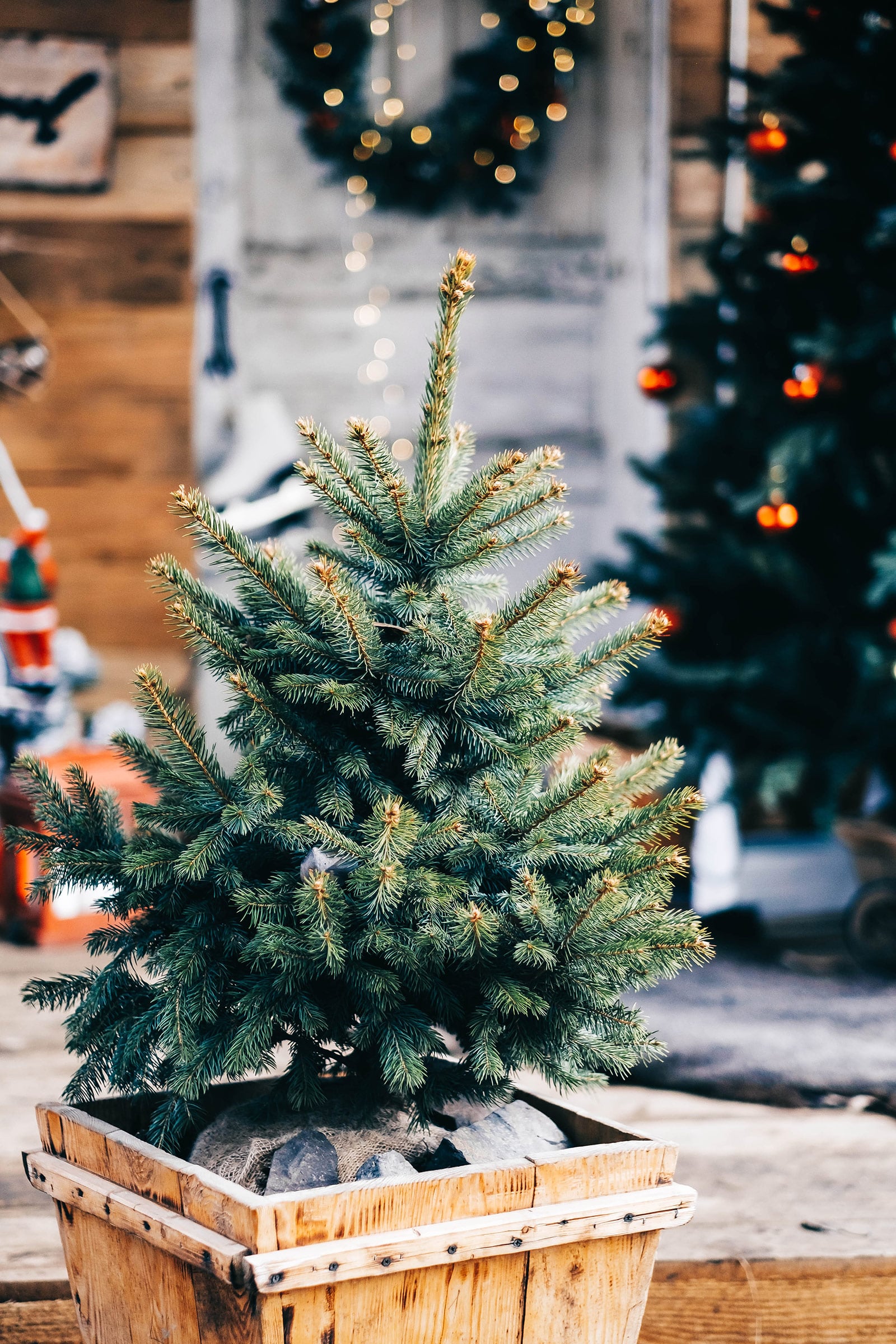
How to plant a potted Christmas tree after the holidays
Happy New Year! Once the holidays are over and your tree has done its decorative duty, it’s time to prepare it for being planted outdoors.
You can start by freeing it of its ornaments and placing it back in the garage (as described in the section above on acclimation) to help transition it back to cooler temperatures. If you have a greenhouse, that would be a great temporary spot too.
After this, your tree can go in a sheltered (but not dark!) outdoor location for a bit, preferably until spring has sprung or at least until the ground has thawed. Keep an eye on the soil moisture level during this time and water as needed.
Ready to plant?
Once the soil is thawed and workable, dig a sizable hole that can fit the root ball and then some.
Tip: You do not need to amend the soil or add any fertilizer. Doing so could stunt the development of your tree, as its roots may get used to the amended soil and refuse to grow beyond it into the native soil.
This advice may seem contrary to what you’ve typically heard about planting trees, but new research over the last decade has found that trees grow best in native soil. If you want to improve your soil, simply add a layer of aged compost over the soil each year as a side dressing for your tree.
Center your tree in the hole, backfill with soil, and water it in well. Stake if the tree seems a bit wobbly due to its small root system. That’s it!
Spread a layer of organic mulch (like wood chips, shredded bark, or leaf litter) around the tree, taking care not to build up a “volcano” of mulch over the base of the trunk. Keep the mulch a few inches away from the trunk and give the tree plenty of water until its roots are established.
Now it’s just a matter of keeping your fingers crossed and hoping your tree survives the transition. Any new growth (light green, soft needles appearing on the tips of the branches) is a good sign that it has established itself and will make it.
Be sure to keep an eye on the tree when summer sets in, keeping it well-watered. Come December, you can use some weather-proof decorations to give your yard a little Christmas cheer.
Tip: Some folks buy a potted Christmas tree with the idea of planting it in springtime and then digging it up again to take it indoors for another round during the next holidays.
This sounds fun, but it’s not the best idea, as the chances of survival are pretty low. Try a service that lets you rent a Christmas tree every year if you want to do something similar!
Can you repot a potted Christmas tree?
You can repot your living Christmas tree into a larger container and keep it in there year-round for reuse during the next holiday season, but…
It’s quite challenging to keep it alive this way as a “houseplant.” All of my attempts (on a conifer, at least) have ended up drying out during summer despite my efforts to provide the best possible care.
If you want to keep a potted Christmas tree going as a houseplant, I recommend getting a rosemary shrub (the holiday kind that’s been pruned into an A-line shape) to add some fragrant greenery to your home.
Shop all living Christmas trees here and plant them afterward in your garden!
View the Web Story on how to care for a potted Christmas tree.


